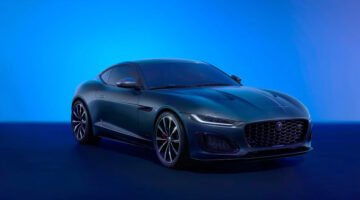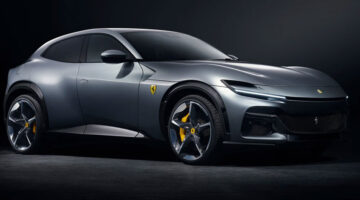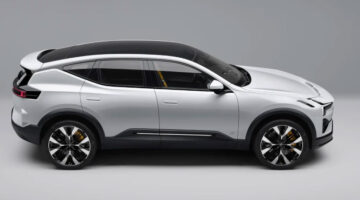Volume car producers cannot ignore the growing demand for compact SUVs and even Jaguar has taken the bait with a new model that could be it’s most important ever.
| Engine | Power | Torque | 0-100kph | Top speed | Weight | Price |
|---|---|---|---|---|---|---|
| Turbocharged, in-line four cylinder 1999cc | 296hp @ 5500rpm | 295lb ft @ 1500rpm | 6.0sec | 243kph | 1819kg | $67,000 |
| Good looking, excellent engine and great fun to drive | |
| Some cheap interior materials, feels nervous on rough surfaces |
You have to hand it to Jaguar (and Land Rover), they really know how to put on a launch event that puts their new cars through their paces. There’s no hiding away a car’s flaws by cutting short on routes or ensuring there’s nothing but perfect black top to drive them on. Unlike some manufacturers, they actually encourage the world’s media to give them some punishment so, rather than have to wait until a new model is available in our own territories, we’ve already got a decent handle on its real world attributes. And Jaguar’s new E-Pace is no different.
As we fly in to Corsica on one of the most frightening flights I’ve ever experienced, and I peer out of my cabin window, two things are obvious: the weather is horrific – hence the terror, followed by an aborted landing – and the terrain on the Mediterranean island is far from ideal for a car with middling abilities, with seemingly nothing but twisting mountain routes snaking across landscapes that look like they could form part of Jurassic Park. No wonder the WRC’s Tour de Corse, which is held here, is known as “The Rally of 10,000 corners.”
Normally a Jaguar would be perfectly at home on challenging roads such as these but this is a new kind of cat altogether. The E-Pace (no, that letter doesn’t stand for ‘electric’, the I-Pace will take care of that when it appears) is a compact crossover – the sort of vehicle that brand stalwarts probably never thought they’d see sharing showroom floor space with XJs and F-Types but one that’s becoming vital to the bottom line of numerous carmakers. This is what the buying public wants, so this is what they’ll get.
If you thought the F-Pace SUV was a step too far, you’d probably be best turning the page to read something else but nobody can deny that Jaguar needs a true volume seller. Just a few years ago, the company was just about managing to shift 60,000 cars a year. Then the XE saloon was launched and things began to pick up but the introduction of the F-Pace two years ago changed everything. Jaguar sells 60,000 of these things alone. And the introduction of this, its smaller sibling, will no doubt see the company’s fortunes go from strength-to-strength.
Visually it’s fair to say that the E-Pace looks much better when you’re looking at it in person rather than in photographs, which can hide some of the cleverer styling nuances. It’s well proportioned and the front and rear overhangs are cleverly executed to appear shorter than they really are. Out back the tapered lines make it look squatter and more sporting even than the F-Pace, and the height of its roofline is really well disguised – something that you really need to see in the metal to appreciate. Most importantly of all, though, it still looks unmistakably like a Jaguar. To my mind the front lamps could have done with being a bit sleeker but that’s nit-picking, although I find the overall shape to be quite colour sensitive.
Inside there’s much for family buyers to appreciate. The boot offers 577 litres of storage space and the seating accommodation is sizeable enough for five, and there’s a pleasing, fuss-free simplicity to the cabin design that really appeals. It continues with the driver-focussed ergonomics introduced with the F-Type and the ambience is pleasingly sporty, although some of the plastics used do the brand a disservice – they’re not up to the standards of Jaguar’s German competitors, which is a shame.
The engine, a 2-litre turbo unit shared with a wide number of JLR models, is fantastic. Plenty of punch is there to be had, thanks to its 296bhp output, and there’s a nine-speed automatic channelling the torque to all four wheels via a GKN four-wheel drive system that happens to be shared with the crazy Ford Focus RS. Unlike the Ford, in this instance it divides up the torque to a maximum 50/50 ratio front and rear, although it does feel like the car is being pushed from behind.
Despite the clever styling, there’s no escaping the fact that cars with exterior dimensions such as these are going to be compromised in the handling department. At 4.4 metres long and 1.65 metres
tall, the E-Pace’s vertical stature is something that its design engineers would have had their work cut out with, if it’s to feel like a Jaguar when it counts. And in most respects it does. You can throw this thing around like it’s a hot hatch in the corners but it still rides with silky smoothness on the main roads and motorways.
Being a top-of-the-line HSE model, my test car rides on 20-inch rims (21s will be offered soon, as will adaptive suspension) and I can’t help feel that there’s a nervous twitch from the chassis once I get onto some rougher surfaces. No doubt the sizable wheels and normally sprung underpinnings are responsible and I’m looking forward to experiencing an E-Pace once it’s treated to a more advanced suspension set-up to see whether or not my suspicions are founded.
Driving it with some gusto, it reminds me a great deal of the Evoque, which could be something to do with the fact that it’s based on the funky Range Rover’s platform, which is also shared with the Discovery Sport. But there’s a dynamism at play here that’s much more suited to Jaguar – there’s no pretence about the E-Pace being a hardcore mud-plugger, its natural habitat is always going to be the road.
These Corsican roads are narrow and any error on the part of a driver could prove fatal in parts, the mountain routes often bordered by vertiginous rock faces to one side and death dealing drops to the sea on the other. To carry any sort of meaningful speed on these kinds of highways, you need to concentrate hard but it does help if your vehicle is as focussed as possible. To this end, the E Pace definitely delivers with a fleet-footed agility that impressively disguises its more than 1,800kg kerb weight, which is heavier even than the F-Pace.
Jaguar knows it and so do we. This new model will quickly become its biggest seller. Time will tell how GCC buyers take to it but it’s absolutely perfect for the European market where Jaguar is hoping to convert saloon car buyers who desire increased practicality without sacrificing desirability. And the E-Pace, like any modern Jaguar, is most definitely desirable



